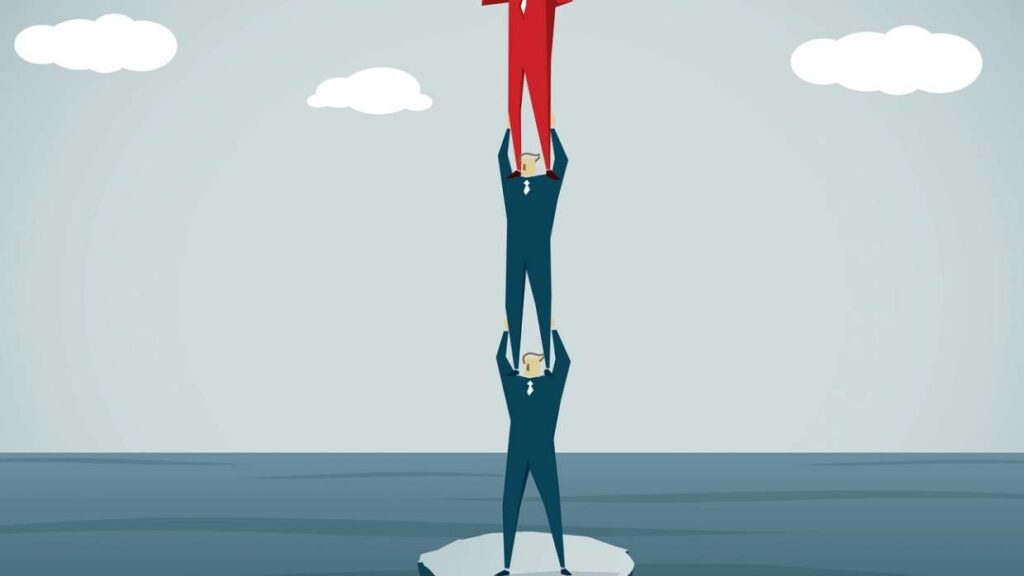In my last three articles, I’ve spoken about the things a team needs to focus on to become a winning team – with the main emphasis being on the team itself and its members.
It’s fair to say that some people object to the term ‘winning’ to describe a business team because the implication is that if your team is winning, other teams must be losing. And that creates unproductive conflict.
Whilst this might be true in the context of sport, I don’t believe it should be true in the context of corporate or organisational life. So we need to change our ‘lens’ or perspective and think about this:
A winning team enables others to win.
A winning team has ‘power with’ rather than ‘power over’ others.
In my last article, I wrote about the six habits that help teams to win.
The final habit is the ‘ask for feedback’ habit.Winning teams ask each other for feedback.
Short, sharp, simple and impactful feedback and/or what Marshall Goldsmith describes as ‘feedforward’. They trust each other to tell the truth in a way that is constructive and future-focused rather than finger pointing and critical.
But they don’t only give feedback to and receive feedback from each other.
(And a quick thought here for you to ponder: teams and organisations that are extremely good at giving and receiving feedback well – and often – have no need for box-ticking yearly appraisals or PDRs).
Winning teams don’t operate from a bubble. They ‘get out there’, put their heads above the parapet and take a global view.
They ask themselves this:
What do our stakeholders need from us – today, tomorrow and in the future? And how can we find out?
‘Surveys? Focus groups? Questionnaires? Customer feedback? It all sounds like a lot of work, and a lot of expense’ I hear you say.
But that is not necessarily where winning teams focus their energies first of all.
Winning teams like to keep things simple at first – organisational life is busy, complex and ambiguous enough.
There are times when research, deep analysis and data are required. Absolutely.
But in my experience, there are many times when good communication and conversation can provide many of the answers – or at least a starting point for some further investigation or fact-finding.
Winning Teams get out of their bubble
Winning teams spend time on relationship building – across all stakeholder groups.
They’ve learned how to ‘do’ dialogue really well.
Winning teams have learned how to have real conversations that make a difference.
They’ve worked hard on developing their questioning and listening skills and their ability to empathise (and winning teams, like most of us, would say these skills are always work in progress and we should never stop practising!)
They’ve worked hard on creating an environment where stakeholders are able to say what they think and feel knowing that they will be truly listened to.
(That doesn’t mean they accept whingeing, moaning, finger pointing or others playing the blame game – they take a position of ‘joint responsibility’ and ask their stakeholders to do the same).
So where is the best place for your team to start?
Well, that depends. But firstly I would like to share some examples of how teams I am working with have started to cast their net more widely and think much bigger and deeper than their own immediate team and its members.
The Eight Hour Revolution
Two of the best teams I’ve worked with in the last couple of years use my eight hour revolution idea (link) to focus on that question I identified earlier:
What do our stakeholders need from us – today, tomorrow and in the future? And how can we find out?
And they’ve invited some of these stakeholders (suppliers, customers, staff members from across the business, community members) to talk to them about this very question – informal, no PowerPoint, simple but powerful exchange of ideas.
In one team, this has led to some small but significant changes. Changing some of their administrative processes, for example, where there was too much duplication and un-necessary form-filling.
They’ve also given more junior team members much higher levels of authority so that decisions don’t have to be escalated up the ‘chain of command’.
Not earth shattering I’m sure you will agree, but a starting point (and they’ve only had two ‘Revolution’ meetings at the time of writing so I predict great things in the future for them as they focus on other stakeholder groups inside and outside the organisation).
Build a bridge (not a wall)
Another team leader, responsible for two separate teams wanted them both to get closer to ‘winning’. Whilst each individual team was high performing and demonstrated many of the characteristics of a winning team, the big stumbling block was their relationships outside their own team – specifically with the other team.
So what did he do? Brought both teams together, of course.
With a facilitator.
Offsite, informal. No slide decks or passive listening.
Started with some work in pairs (each pair comprised one member from each of the two teams).
A ‘six degrees of separation’ exercise.
Sharing their biggest challenges and questions for the other team.
But what they were actually doing was getting to know each other as human beings (many of the teams’ members had not met each other except by email even though they’d worked together for months or even years).
‘All the usual stuff’ I hear you say.
It’s not rocket science. But the thing is, we often kid ourselves that things won’t change (avoidance and denial) and that something complex needs to happen for two teams to work together.
Not so in my experience. Getting people to talk to (and note TO not AT) each other is ALWAYS the best place to start.
Focus on something ‘bigger than both of us’
After this one day event, these two teams decided to cast the net wider to some of their joint stakeholders inside and outside the business. This culminated in the first of what is now a quarterly coffee morning in aid of charity (altruism has brought them all together for a common purpose). (link)
This seemingly simple activity has had a huge positive impact on the way people across teams relate to each other. Getting to know each other as people behind the role title, united in doing something ‘bigger than all of us’ has meant that a lot of work tasks now get done with a much smaller email trail and ‘backside covering’ than ever before!)
Meet the Boss(es)
Another organisation has informal ‘meet the CEO’ lunches quarterly with a variety of stakeholders. There is no ‘state of the nation’ address and then deathly silence when she asks for ‘any questions’.
Instead, the ‘guests’ are seated on tables of six and each group has an opportunity to ask two question of the CEO and also to give one idea about what the organisation might do differently in the next six months.
Another does a similar exercise with the whole executive team present. It’s been so successful they are going to ask each team to take a turn at doing a similar exercise over the next twelve months.
The empty chair
Yet another team has a ‘stakeholder’ chair in their meeting. It’s an empty chair. Any of the team members can take the ‘empty chair’ at any time and speak ‘with the voice’ of a stakeholder.
‘What would the HR Manager want to ask us if she were in this chair?’
‘What questions would the FD ask us right now’?
‘What would our oldest customer make of this?’
Of course, this felt weird at first. But they stuck with it and have become increasingly bolder and braver in imagining what their stakeholders might think, feel, say or do.
They always have a ‘press’ stakeholder chair, too. To ask that famous ‘How would this look on the front page of the Sunday Papers?’ question of each other.
Build a solid foundation
A third sector organisation I worked with last year was replacing most of the Trustee Board. The CEO wanted to have a different type of relationship with the new board members.
So he started by meeting each of them individually for coffee – and encouraged his executive team colleagues to do the same prior to their first formal meeting.
At the first board meeting, rather than dive into ‘task’ (previously they’d spent most meetings ploughing through reams of reports) they spent some more time getting to know each other and establishing some ways of working.
The time spent ‘laying the foundations’ has been hugely instrumental in helping them to get some things done that they’d previously only talked about – one of which was to bid for a large amount of funding which means they can impact their community very powerfully in many new ways – a real example of a winning team enabling others in the ‘wider world’ to win.
The power of simplicity
You might argue that none of the examples shared above are ground-breaking or ‘new’.
And that’s exactly my point.
The power of all these things is in their simplicity. Every team can decide to do something similar without having to invest huge amounts of time and resource.
The key is to make a start.
Winning teams don’t just talk about things – they take action.
So, how can your team enable others to win?
What is your starting point?
Lynn Scott is the author of The Effortless Leader Revolution: The Four Pillars of Effortless Leadership, available for download free today.






